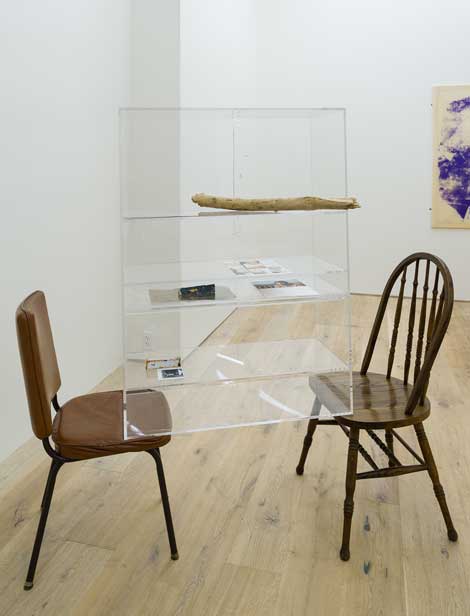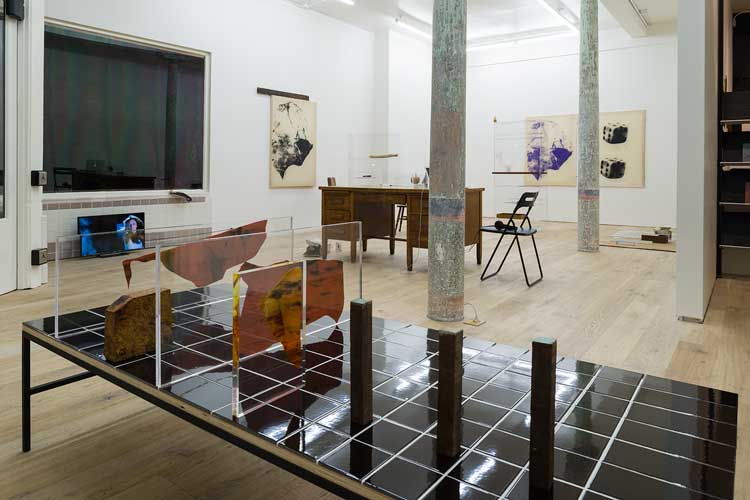In his first solo show in the U.S., French artist Benoît Maire includes a video presented on a MacBook showing an image of another MacBook showing a video of the artist watching a video of Foucault on YouTube (on a MacBook). Foucault is shown praising Gaston Bachelard for his ability to level cultural hierarchies by opposing minor poets and obscure writers to canonical figures like Descartes. The hall-of-mirrors effect is grating: the “hyperreal” yet again (and again). Nevertheless, when the camera pans to the actor, deadpan, neatly dressed with a head shaved to match Foucault’s, it asserts Maire’s affinity with this idea without seeming too pretentious.
It also explicitly states the theme of his show. His assemblage pieces embrace with mixed results this idea of leveling hierarchies. The materials, for instance, are all self-consciously heterogeneous. He includes, for instance, scraps of wood and other detritus (an empty bottle of linseed oil) used in the creation of these works. Maire calls these objects “indexed waste” and emphasizes this with the recurrent image of hand extending an index finger—a motif referring to both Duchamp’s The Large Glass and a large body of academic writing on the topic of “indexicality.” Unfortunately, the references to major canonical figures affirm some very familiar hierarchies and the “indexed waste” can by now only seem like conventional “nontraditional” art supplies.
In Love Being (all works 2015), for instance, various objects are arranged on pristine Plexiglas shelving. The top shelf includes a large termite-ridden stick with the word “OTHER” printed on it. Below we find—among other things—a copper sheet with the phrase “LOVE BEING” and a scrap of wood imprinted with the word “ACTUALLY.” At first this seems like a riddle, but that’s the point: the deferral of meaning itself alludes to the interchangeability of all these materials—as if they were floating in a vast ephemeral white void. The stylishly austere shelving recalls other artists who deal with methods of display: notably, Josephine Meckseper, Carol Bove and Haim Steinbach. However, Maire is less interested in the means of presentation and more invested in the idea of its transparency.
Other pieces here explore similar ideas in different formats. New Durer Table includes several vertical Plexiglas panels with paint smears sandwiched between them on a low-lying tiled platform. A prison shiv sits inconspicuously in the corner. There are three silkscreen paintings (two of a rock and one of two dice) which recall Nate Lowman’s silkscreens, but more shiny and elegant—given a glossy sheen with a final layer of linseed oil.
A floor-piece titled ha ha ha ha includes a video presented simultaneously on two TVs sitting on opposite sides of the gallery. An attractive woman swings a tennis racket and hits an off-screen tennis ball. The “pock -POCK” rebounds across the room in a metronomic aural rhythm as insistently regular as the grids in his sculptures. Formally and conceptually it is mesmerizing and loaded. However, the subject matter is somewhat questionable in this context, as if to say “Just what one needs after a session with Foucault: a sexy lady engaged in strenuous physical activity.” So very French.
All Photos by Johnna Arnold. Courtesy the artist and Kiria Koula, San Francisco
Show ends March 7, 2015
Kiria Koula Gallery
3148 22nd Street
San Francisco, CA
94110 USA
http://www.kiriakoula.com/





